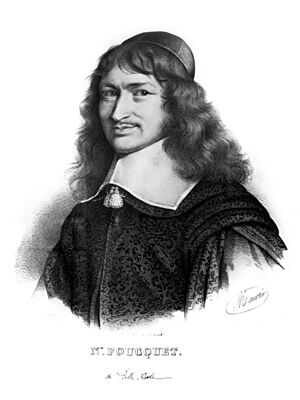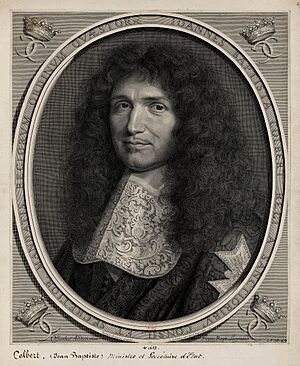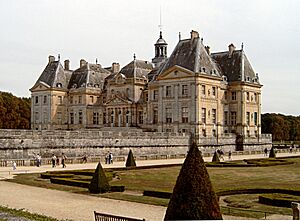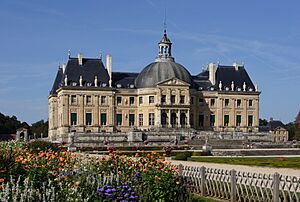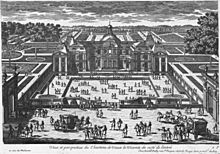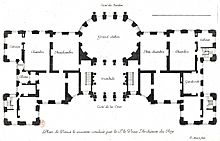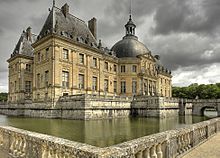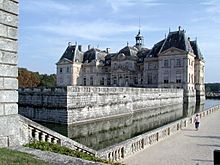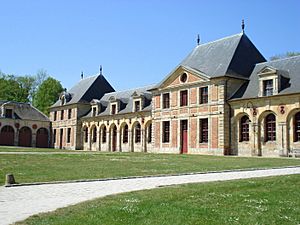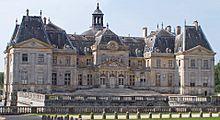Vaux-le-Vicomte facts for kids
Quick facts for kids Château de Vaux-le-Vicomte |
|
|---|---|

View from the rond d'eau of the garden
|
|
| General information | |
| Type | Château |
| Architectural style | Baroque |
| Town or city | Maincy |
| Country | France |
| Construction started | 1656 |
| Completed | 1661 |
| Design and construction | |
| Architect | Louis Le Vau |
The Château de Vaux-le-Vicomte is a beautiful French castle built in the Baroque style. It is located in Maincy, a town near Melun, about 55 kilometers (34 miles) southeast of Paris, France.
This amazing château was built between 1658 and 1661 for Nicolas Fouquet. He was a very important person, the Superintendent of Finances for King Louis XIV. Vaux-le-Vicomte became a very important building in Europe for its architecture in the mid-1600s.
For the first time, three talented artists worked together on this huge project:
- The architect Louis Le Vau designed the buildings.
- The landscape architect André Le Nôtre created the gardens.
- The painter Charles Le Brun decorated the inside.
Their teamwork started a new style called the Louis XIV style. This style combined architecture, interior design, and garden design all into one grand plan. The long, straight main path in the garden is a great example of this style.
Contents
History of Vaux-le-Vicomte
The land where Vaux-le-Vicomte stands was once a small estate between two royal castles. In 1641, Nicolas Fouquet bought it. He was a young, ambitious man who loved art and supported many artists.
When Fouquet became King Louis XIV's finance minister in 1656, he decided to make his estate even grander. He hired Le Vau, Le Brun, and Le Nôtre to transform his home and gardens. Fouquet's love for art helped these three artists do their very best work.
To make space for the huge gardens and castle, Fouquet bought and tore down three villages. The people who lived there then helped work on the gardens. It is said that 18,000 workers were involved, and the project cost a huge amount of money – about 16 million French livres!
The château quickly became a famous place for parties, plays, and art. Famous writers like Jean de La Fontaine and Molière were friends with Fouquet. At the opening party for Vaux-le-Vicomte, a play by Molière was performed. There was also a fancy dinner and an amazing fireworks show.
The Grand Party and Fouquet's Arrest
Vaux-le-Vicomte was incredibly beautiful and luxurious. But these very qualities led to trouble for its owner. King Louis XIV had Fouquet arrested soon after a famous party on August 17, 1661. Molière's play 'Les Fâcheux' was first shown at this party.
The celebration was simply too grand, and Fouquet's home seemed too luxurious to the king. Fouquet had wanted to impress the king, and part of Vaux-le-Vicomte was even built especially for the king's use. However, his plan did not work out as he hoped.
Jean-Baptiste Colbert, another important minister, made the king believe that Fouquet's wealth came from misusing public money. Colbert then took Fouquet's place as finance minister and had him arrested. The writer Voltaire later famously said about the party: "On 17 August, at six in the evening Fouquet was the King of France: at two in the morning he was nobody."
What Happened After Fouquet?
After Fouquet was arrested and put in prison for life, and his wife was sent away, Vaux-le-Vicomte was taken over by the government. The king took 120 tapestries, many statues, and all the orange trees from the château. He then sent the same team of artists – Le Vau, Le Nôtre, and Le Brun – to design an even bigger project: the Palace of Versailles.
Fouquet's wife got her property back 10 years later. She lived there with her oldest son. In 1705, after her husband and son passed away, she decided to sell Vaux-le-Vicomte.
Vaux-le-Vicomte Today
Marshal Claude Louis Hector de Villars bought the château in 1705 without even seeing it. In 1764, his son sold the estate to the Duke of Praslin. His family owned the property for over a century.
In 1875, after being neglected for thirty years, the estate was sold at a public auction to Alfred Sommier. He loved art and especially wanted the paintings by Charles Le Brun inside the château. At that time, the château was empty, some buildings were falling apart, and the gardens were completely overgrown.
Alfred Sommier began a huge restoration project. He worked with architect Gabriel-Hippolyte Destailleur and landscape architect Elie Lainé. When Sommier passed away in 1908, the château and gardens looked like they did when they were first built. His son, Edme Sommier, and his wife finished the work.
Today, Alfred Sommier's descendants continue to take care of the château. It is still privately owned by the Count and Countess de Vogüé, who received it as a wedding gift in 1967. Vaux-le-Vicomte is the largest private château in France, with huge gardens covering 1,235 acres.
The property opened for public tours in 1968. A major restoration project started in 1976 and was still ongoing in 2017. Just fixing the roof took six years! The beautiful Baroque ceiling in the Chambre des Muses, decorated by Charles Le Brun's workshop, was restored in 2016–2017. It was first shown to the public in March 2017.
Now, the Count and Countess's three sons manage the château. They are dedicated to keeping it preserved. They have a ten-year plan for restoring the buildings and gardens. They even make this plan public so people can help sponsor specific projects, like restoring a statue.
About 300,000 people visit Vaux-le-Vicomte each year, with most visitors coming from France. The French government recognizes it as a monument historique, meaning it's a very important historical site. The château is open most of the year. During the Christmas season, it is decorated with 150 trees, 10,000 items, and 4,000 meters (4,374 yards) of garlands and lights. It is usually closed for about two months in winter.
What Makes Vaux-le-Vicomte Special?
Amazing Architecture
The château is located at the northern end of a long path, about 1.5 kilometers (0.9 miles) long. The front of the castle faces north. Both sides of the building are perfectly symmetrical, meaning they are mirror images of each other. Even the inside layout is almost completely symmetrical!
The two rooms in the center, the entrance hall and the oval salon, were originally open-air spaces. This meant they were decorated like outdoor areas. Three sets of arches line up perfectly, allowing visitors to see all the way through to the garden's main path as they arrived.
Instead of one large staircase, there are two symmetrical staircases on either side of the central hall. The rooms on the eastern side of the house were for the king, and those on the western side were for Fouquet. It was common for important houses to have rooms ready for the king, as he traveled often.
Another interesting feature is how thick the main part of the building is. It has two rows of rooms, which was new for castles at the time. Most French castles only had one row of rooms in the middle. Also, the main rooms are on the ground floor, not the first floor, which was unusual. This is why there isn't a grand staircase, which was common in other castles.
The château is built on a platform surrounded by a moat, like an old medieval fortress. You reach it by two bridges, one on the north and one on the south. This moat was a charming old-fashioned touch that Le Vau might have copied from another castle.
The bridge on the north side leads to a large courtyard. This courtyard has raised terraces on either side, which reminds people of older noble houses. In those older homes, the entrance courtyard was surrounded by wings that held kitchens and servant quarters. At Vaux, these facilities were placed in the basement, so the extra buildings were not needed.
The main château is made entirely of stone. However, the service buildings next to the main courtyard are made of brick and stone. This showed a difference in importance between the buildings.
The entrance side of the château looks very French. It has two side sections next to a central part. These parts are topped with steep, pointed roofs. These steep roofs were a style from medieval times and were quickly going out of fashion. Le Vau never used them again after Vaux.
The garden side of the château is considered even more beautiful. A huge, two-story Grand Salon sticks out from the main building. This salon has a massive slate dome with a tall lantern on top. It also has a two-story entrance that looks very similar to one Le Vau designed for another building. Using a central oval salon was a new idea Le Vau got from Italy.
The Magnificent Gardens
The château sits on a raised area in the middle of woods. The garden, designed by Le Nôtre, is the most important part of the whole estate. It stretches for almost 3 kilometers (1.8 miles)! It has a perfect balance of water pools, canals, fountains, gravel paths, and patterned flowerbeds. It is even more organized than the huge gardens Le Nôtre later created at Versailles.
The land naturally had a lot of water, with two small rivers meeting in the park. One of these rivers was turned into the Grand Canal, which leads to a square pool.
Le Nôtre designed the garden to look amazing when viewed from the house. He used tricks of perspective to make it seem even grander. For example, he placed the canal at the lowest point, so you couldn't see it from the main viewpoint at the château. Beyond the canal, the garden goes up a large grassy area and ends with a Hercules column, which was added later.
Hidden Tricks in the Garden Design
Le Nôtre used a clever optical illusion in his garden design called anamorphosis abscondita, which means 'hidden distortion'. This trick makes things look closer than they really are. For example, the reflecting pools are narrower closer to the château and wider farther away. This makes them appear closer to you when you stand at the back of the château.
From a special viewing spot at the top of the stairs behind the château, the garden looks like it's all revealed in one glance. The distortion makes the garden seem much larger than it actually is. These visual tricks are not easy to see in photos, so you really need to visit the gardens to experience them fully.
When you first look from the grand staircase, you see rows of bushes, paths, fountains, statues, and flowers. These elements show the Baroque desire to shape nature to fit human wishes. The main feature is a large reflecting pool with grottoes (small caves) holding statues.
As you walk through the garden, you discover that it is much bigger than it first appeared. You pass a circular pool that looked oval from far away. Then, a canal that cuts through the garden is revealed, along with a lower path. As you continue, a second pool appears to be square, and the grottoes and statues become clearer.
However, when you walk towards the grottoes, you realize they are on a much lower level than the rest of the garden. They are separated by a wide canal that is almost a kilometer (over half a mile) long. This optical effect is due to how our eyes see distant parts of a lower surface as being higher.
In Fouquet's time, visitors could cross the canal by boat. Walking around the canal gives you a view of the woods beyond the garden and shows how the grottoes were distorted to look like sculptures from afar. Once you pass the canal and grottoes, you reach the large sloping lawn. From this point, looking back, the distortions make the gardens seem much longer than they actually are. The many discoveries you make as you walk through the garden are very different from the single, static view you get from the château.
See also
- List of Baroque residences
- History of early modern period domes
- List of tourist attractions in Paris


